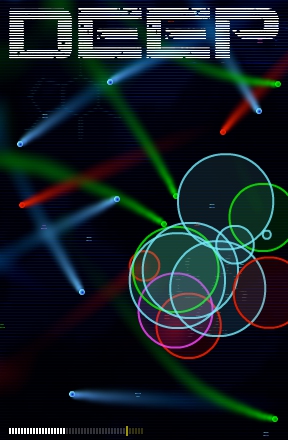 Perhaps, dear casual gamer, you've previously had a chance to play Boomshine, a colorful game involving what I call "splodey circles," which turns colorful dots into other splodey circles, which spirals into a chain reaction of many-hued, pyrotechnic eye-candy. Like fireworks, or pinball, Boomshine creates a bright, flashy, stimulating display for the happy player. But also like pinball (at least when I play it), Boomshine and its many imitators don't always foster a sense that the player can do much to control the outcome of the game. You pretty much click on some hopeful spot and watch the pretty reactions unfurl. Improving on the formula is Alexey Perepechko's
The Deep, which serves up the same scintillating experience as Boomshine while giving players a bit more control over the reactions they precipitate.
Perhaps, dear casual gamer, you've previously had a chance to play Boomshine, a colorful game involving what I call "splodey circles," which turns colorful dots into other splodey circles, which spirals into a chain reaction of many-hued, pyrotechnic eye-candy. Like fireworks, or pinball, Boomshine creates a bright, flashy, stimulating display for the happy player. But also like pinball (at least when I play it), Boomshine and its many imitators don't always foster a sense that the player can do much to control the outcome of the game. You pretty much click on some hopeful spot and watch the pretty reactions unfurl. Improving on the formula is Alexey Perepechko's
The Deep, which serves up the same scintillating experience as Boomshine while giving players a bit more control over the reactions they precipitate.
Each level contains a field of colorful "electrons," slowly floating along a set trajectory. Your job is to start a reaction (the aforementioned "splodey circle") by clicking somewhere on the screen, then gently herding the electrons in the reaction before it expires, perpetuating the explosion of colors until you consume a set number of electrons. This means using the movement of your cursor, which repels electrons for most levels, to push them where you want them to go. Different colored electrons have special effects when they react, some good, some bad, which means you sometimes want to keep certain electrons away from your reactions. Also, while most levels require you to consume a certain number of electrons, others have different goals, such as consuming as few electrons as possible while setting a certain number of reactions.
The simple addition of being able to steer your electrons is a clever enough innovation on the Boomshine concept to make The Deep worth playing, but the developer seems to have realized all the possibilities in his idea and developed it into a great variety of gameplay. The different types of electrons and levels generate many ways to play with the core concept without ever feeling gimmicky or strained. The presentation is top-notch too: The graphics and animations are colorful and atmospheric without being distracting, and the ambient soundtrack really sets the mood, especially the joyful, ethereal theme that kicks in when you complete your goal. With its pretty production and well thought-out gameplay, The Deep is a clever twist on a familiar game that fully maximizes its potential.






Walkthrough Guide
(Please allow page to fully load for spoiler tags to be functional.)
What the colors mean: (Thanks to JiG reader Valtiel and Two Towers Games)
"Light blue atoms: The default atom. They add to your score and add a new explosion that keeps the reaction going.
Dark blue atoms: Slow moving and turn around a lot. Collecting them spawns ten new light blue atoms at the sides of the field. Collect these as early as possible.
Red atoms: While red atoms do add to your score, the red explosion they leave behind is bad news - any atoms touched by it are destroyed without adding to your score. Most levels with red atoms require you to collect them - the trick is to always have a blue explosion nearby that you can steer other atoms into.
White atoms: Give you an additional click with which to start a new reaction, but don't explode and don't add to your score.
Yellow atoms: Turn your cursor "magnetic" - it attracts rather than repels atoms. Collect a second yellow and the effect reverses. I don't think these explode. Keep track of them, because if you collect one and don't realise it, you've probably lost by the time you've worked out why the atoms aren't behaving as they should.
Brown atoms: Cause you to immediately lose.
Green atoms: Behave just like light blue atoms, but every time one is collected, every other atom speeds up slightly. Avoid for as long as you can, they make the game ridiculously chaotic."
"Ochre atoms: Increases the time that the ring kept open.
Purple atoms: Slightly increase the radius of the rings."
To beat the stages highlighted by a red star (Defense type): (Thanks to reader superdan)
You need to place all of your starting charges in one go (once you start, there must always be an ongoing reaction) and ward off as many of the other particles as possible. You are allowed a certain number of hits. An easy way to do this is to choose a corner, take a little time to clear out the incoming particles, and rapidly click to drop all your charges in that corner. Note that you cannot drop a charge into an area that already has an ongoing reaction, hence the rapid clicking.
Posted by: Mike |
January 30, 2011 7:02 PM
|
January 30, 2011 7:02 PM